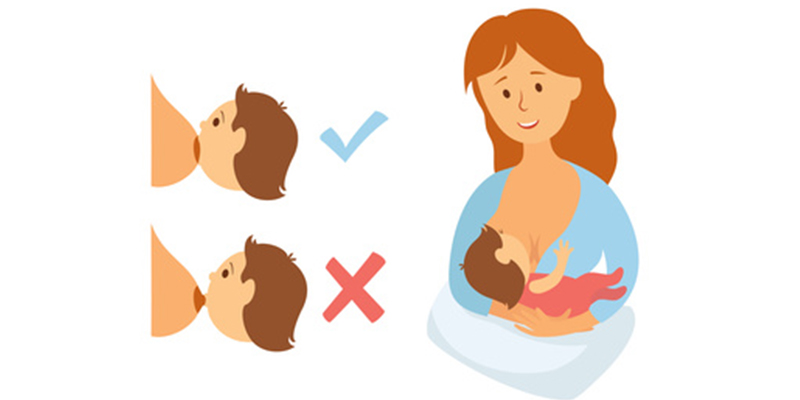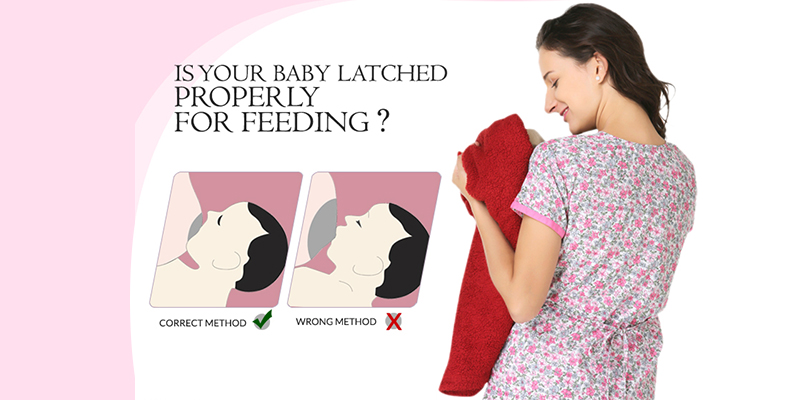
In any of the nursing positions, when the baby is well aligned you should be able to draw a straight line that connects the baby’s ear, shoulder, and hip on either side of the baby’s body.
Once you and your baby are in proper position, the next step is to guide him toward the breast so that he can latch on properly and nurse. Latching on effectively is crucial to breastfeeding successfully because it prevents sore nipples, ensures sufficient milk supply, and stimulates plentiful milk production. In most cases (other than in the reclining position), it will be necessary to support your breast, at least in the early days of breastfeeding, in order for your baby to attach properly. This is especially true as milk production increases your breasts’ size and weight.
The C-Hold
Using your free hand, place four fingers under your breast and your thumb on top to present the nipple to your baby. (Your lactation specialist or nurse may refer to this as a C-hold, since your hand makes the shape of a letter C.) Make sure your fingers are well behind the areola (the darker-colored area around the nipple) so it doesn’t get in the way of your baby’s latching on to the breast. You can provide gentle compression of the breast with your fingers to make it easier for your baby to latch. Alternatively, you can place your fingers on your breast in a scissors or V-hold to guide the nipple, but only if your fingers are wide enough apart to expose the areola.
With the breast supported, stroke your baby’s lower lip with your nipple or bring his chin in to touch the breast closely. This causes him to open his mouth. (If his mouth stays closed, stroke his lip again, press gently down on his chin with your index finger, and open your own mouth, too, since he might imitate you.) When he opens wide—not just a little, but as though he’s giving a big yawn—quickly draw him closer and place his open mouth fully on your breast. This guiding movement should be quick but gentle. Remember that you should bring your baby to your breast, not push your breast into his mouth. If your baby’s head is pushed into the breast so hard that he cannot breathe, he may become agitated or frightened; he may arch his back and refuse to breastfeed.
Good Positioning
If your baby is in proper nursing position, his jaws will come together on your areola and his lips will seal over your breast. His chin and possibly his nose will touch your breast. (He will be able to breathe, but if you are concerned about his breathing, try lifting your breast or changing the angle of his body slightly, pulling his bottom in more closely to your body.) Helping him to latch on in a slightly asymmetric fashion, so that a bit more of the areola is in his mouth on the lower-lip side and a bit less on the upper-lip side, will position the nipple so it points toward the roof of the baby’s mouth.
You may feel slight discomfort when he first latches on and perhaps even for the first few sucks, but once he begins to suckle steadily you should not feel pain. Pain beyond the first minute or so of nursing is a sign of improper latching on and should be immediately corrected through further practice or with the help of a pediatrician, family physician, nurse, or lactation specialist. When pain persists throughout nursing, detach the baby by inserting your finger in thecorner of his mouth to break the suction and relatch him, making sure that his mouth is wide open before latching.
Last Updated 11/21/2015
Source New Mother’s Guide to Breastfeeding, 2nd Edition (Copyright © 2011 American Academy of Pediatrics)
The information contained on this Web site should not be used as a substitute for the medical care and advice of your pediatrician. There may be variations in treatment that your pediatrician may recommend based on individual facts and circumstances.






